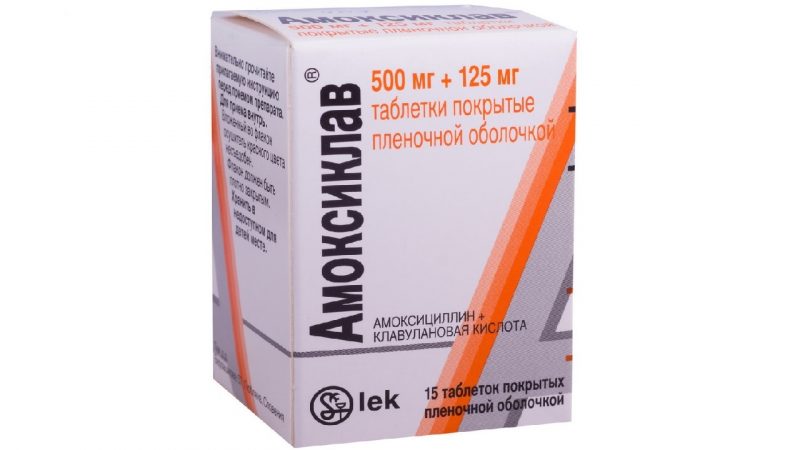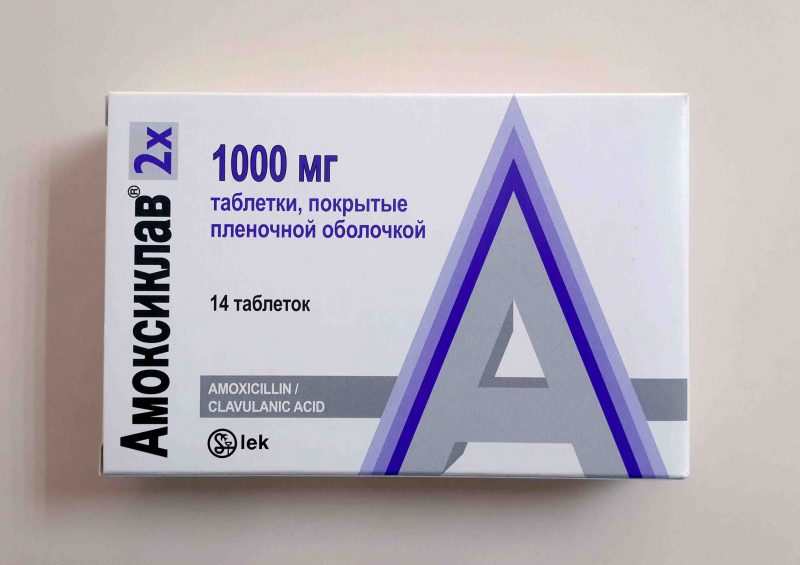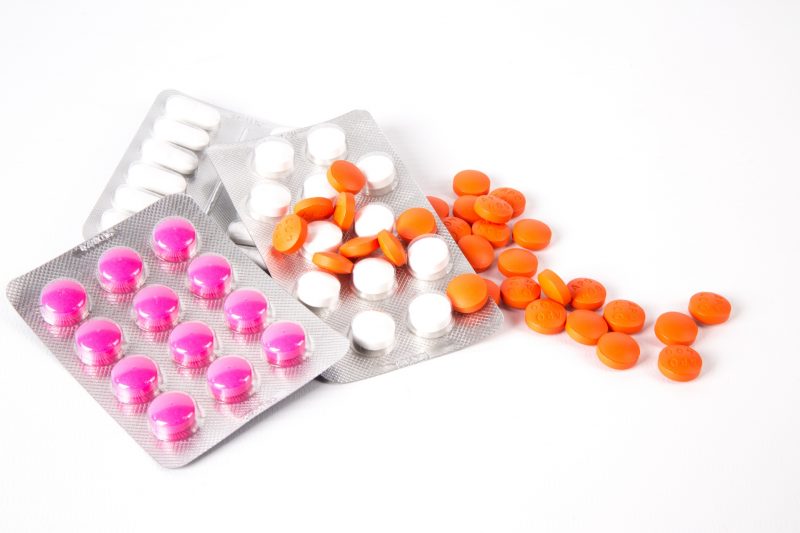For the treatment of painful processes of an infectious-inflammatory nature, antibiotics are needed. But when choosing a specific remedy, it is necessary to take into account many factors in order not to harm health. In this section, we will consider how to use Amoxiclav tablets.
Material Content:
- 1 The composition (active substance) of the antibiotic
- 2 Pharmacological action, pharmacodynamics and pharmacokinetics
- 3 In which cases Amoxiclav tablets are prescribed
- 4 Instructions for use and dosage for adults and children
- 5 During pregnancy and lactation
- 6 Drug interaction
- 7 Can I drink alcohol while taking the drug
- 8 Contraindications, side effects and overdose
- 9 Antibiotic Analogs
The composition (active substance) of the antibiotic
The composition of the drug includes amoxicillin trihydrate and clavulanic acid. Moreover, the first component dominates. As auxiliary compounds, Mg stearate, microcrystalline cellulose, colloidal silicon dioxide, croscarmellose Na and crospovidone are present.
The therapeutic composition is available in the form of tablets. A film membrane is applied to them, they have oval, slightly convex outlines and white color. Sometimes there is a light beige shade. The volume of active substances is indicated by two numbers. First, the content of amoxicillin is indicated, and then - clavulanic acid.
There are such dosages of the drug in tablets:
- 250/125 (0.375 g);
- 500/125 (0.625 g);
- 875/125 (1 g).
The medicine remains suitable for use for 24 months. At the same time, he needs to ensure proper storage conditions, namely a relatively normal humidity and air temperature not exceeding 25 degrees. In pharmacies, the therapeutic composition is dispensed only by prescription.
On a note! There are other forms of release of the drug. This is a powder for suspension with an active substance content of 250/125 mg and a suspension used for the manufacture of infusions. It contains 500/100 mg of the dominant components.
Pharmacological action, pharmacodynamics and pharmacokinetics
This drug is unique in its own way due to the content of two active components that provide a good therapeutic effect. So, amoxicillin, like other compounds of the penicillin group, destroys bacteria by binding their receptors. But at the same time, many types of dangerous microorganisms adapt to this effect and can destroy the antibiotic, secreting the beta-lactamase enzyme.
But clavulanic acid copes with this problem perfectly. It allows you to reduce the activity of this compound, due to which even those components of the pathogenic microflora that were initially resistant to amoxicillin die.
Amoxiclav tablets are taken at any time of the day. Active substances are well absorbed, regardless of food intake, and after an hour reach the maximum concentration in the blood. The distribution speed of the components is quite high, and they quickly penetrate the cells.
If amoxicillin is only partially destroyed in the body, then the metabolism of clavulanic acid is very active. It is produced by the kidneys. In addition, a small part of the substances can be excreted by the intestines, lungs, and they are also present in breast milk.
In which cases Amoxiclav tablets are prescribed
Amoxiclav tablets for adults and children are prescribed as part of the treatment of infections and inflammatory processes.
The use of the drug is justified when the problem is concentrated in such parts of the body:
- ENT organs;
- lower and upper respiratory tract;
- urinary canals;
- genitals;
- bone, cartilage and connective tissues;
- biliary tract;
- skin and soft tissues (including after bites or other mechanical damage).
In addition, the drug is also used for odontogenic infections. They are characterized by the fact that the entrance gate for pathogenic microflora is damaged teeth or connective tissue surrounding them.
Instructions for use and dosage for adults and children
An abstract to the tool states that the children's dosage is calculated based on the patient’s body weight. Patients aged 6 to 12 years need 0.004 g per 1 kg. In difficult situations, the volume may be exceeded. But, in any case, should not be more than 45 mg / 1 kg. For children over this age, admission is recommended according to the adult scheme, which is described below.
250/125 mg tablets
When the disease in an adult is relatively easy, and there are no complications, he is shown taking the drug at the indicated dosage three times a day. In this case, the interval should be at least 8 hours.
It is important to ensure that this time interval is not violated. If it is less, the concentration of the drug in the blood will increase. And in the case when the patient takes the medicine with such a volume of substances every 10-12 hours, the therapeutic effect is weakened.
Amoxiclav 500/125 mg
Tablets of 0.625 g for adults and children over 12 years old should be drunk twice a day (once every 12 hours). This scheme is used when there are no complications.
If they are, on the recommendation of a doctor, it is permissible to take a tablet three times a day with an interval of 8 hours.
On a note. There are dispersible tablets Amoxiclav Quicktab with a dosage of 500/125 mg, which can be drunk only for children under 12 years of age. The interval between receptions in this case is at least half a day.
875/125 mg tablets
The medicine in the highest dosage can be taken no more than twice a day (once every 12 hours). It should be borne in mind that if the patient has impaired renal activity, it is necessary to choose a therapeutic composition with a smaller volume of substance.
Tablets can be swallowed in their entirety or broken in half, as well as taken with water. Most often, the duration of treatment is 14 days. Subsequently, if the desired effect has not occurred, it is possible to replace Amoxiclav 500/125 mg or the same product in a different dosage with an analogue.
During pregnancy and lactation
Taking Amoxiclav is extremely undesirable in the first three months of pregnancy, when the laying of organs in the fetus occurs. And the ban also applies to the period of breastfeeding, since the active substances of the antibiotic are able to penetrate into milk. It is not known what damage these components of the drug can cause to the baby.
In the second and third trimester, Amoxiclav is prescribed only in cases where the intended benefit is significantly higher than the potential harm to a child developing in the womb. It should be borne in mind that the dosage and scheme must be observed very accurately: any deviations can lead to sad consequences.
Drug interaction
The absorption of the medication under discussion will be delayed if it is used in conjunction with drugs of the antacid, glucosamine and aminglicoside groups, as well as with drugs that have a laxative effect. When interacting with ascorbic acid, the opposite situation occurs, and this process is accelerated.
Together with diuretics, allopurinol, nonsteroids and other compounds that affect the functionality of tubular secretion, the concentration of amoxicillin in the blood will be increased.
Rifampicin will weaken the effect of this enzyme. This compound is considered an antagonist to amoxicillin. And also do not take the drug under discussion with other antibacterial agents of the bacteriostatic subgroup, since its effectiveness will decrease. Amoxiclav, in turn, is able to "extinguish" the effect of oral contraceptives.
And also, caution should be exercised while using the medicinal composition with anticoagulants and agents containing methotrexate, disulfiram and probenecid.
Can I drink alcohol while taking the drug
Any antibacterial medications should not be combined with alcohol or medical formulations containing ethanol. In this case, the load on the liver cells increases, which can adversely affect the state of this organ. In addition, taking strong drinks significantly increases the likelihood of side effects.
Contraindications, side effects and overdose
It is forbidden to use Amoxiclav in the presence of the following conditions in a patient:
- mononucleosis of an infectious nature;
- lymphocytic leukemia;
- liver disease, even in the past;
- pronounced susceptibility to the components of the composition.
On a note! Precautions should be taken during treatment for people suffering from severe impaired renal function.
This antibiotic does not provoke pronounced side effects, but in some cases the reaction is manifested by the following symptoms:
- disorders in the urinary system;
- dizziness and pain in the frontal and temporal lobes;
- sleep disturbances;
- decreased appetite, nausea;
- vomiting and severe diarrhea (in rare cases);
- problems with the circulatory system;
- skin allergic signs and swelling;
- cramps (sometimes).
Despite the fact that an overdose of Amoxiclav does not pose a threat to the patient's life, her symptoms are still unpleasant. This condition manifests itself by abdominal pain, vomiting, diarrhea and overexcitation. And in some cases, convulsive attacks may occur.
If not much time has passed from the moment the medication was drunk, washing the stomach and taking activated charcoal will help. But, having provided first aid to the victim, it is still worth calling specialists.
To avoid an overdose, it is worthwhile to strictly observe the dosage regimen. Any violation can lead to negative consequences.
Antibiotic Analogs
If Amoxiclav is not suitable for the patient, it is replaced with the following types of antibiotics in tablets:
- Amoxyl;
- Arlet
- Augmentinum;
- Panclave;
- Flemoklav Solutab;
- Eco Clav.
Means similar to Amoxiclav are used in the same dosage and in the same way as the specified drug. But in no case can you self-medicate, you need a doctor’s appointment, otherwise it will lead to an increase in pathogenic microflora and a deterioration in the general condition.





















